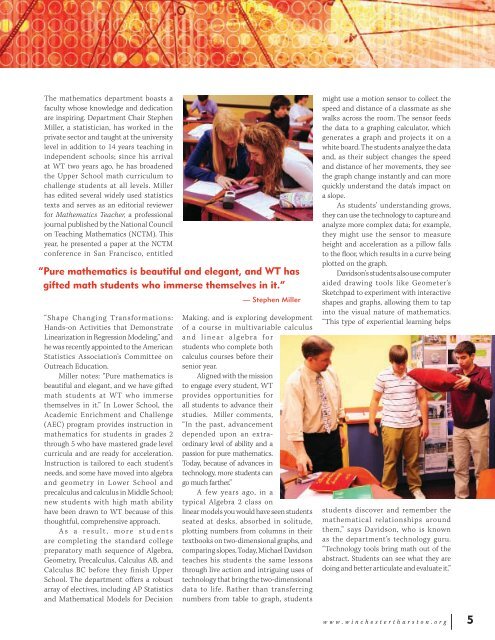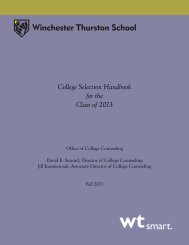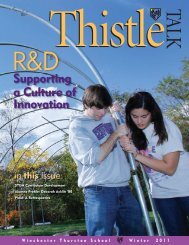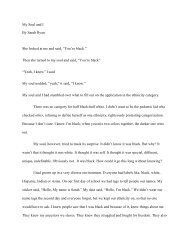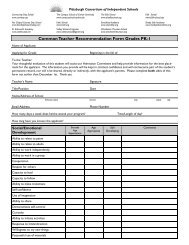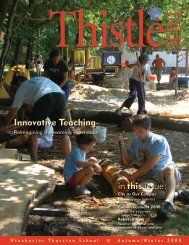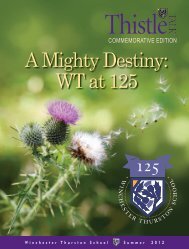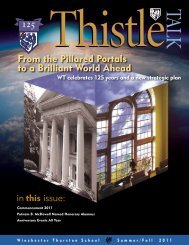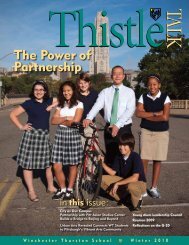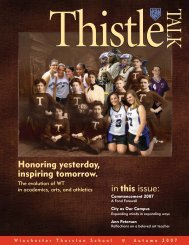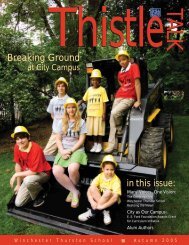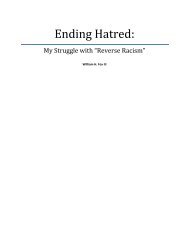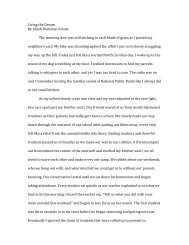Thistletalk Summer 2010 - Winchester Thurston School
Thistletalk Summer 2010 - Winchester Thurston School
Thistletalk Summer 2010 - Winchester Thurston School
- No tags were found...
You also want an ePaper? Increase the reach of your titles
YUMPU automatically turns print PDFs into web optimized ePapers that Google loves.
The mathematics department boasts afaculty whose knowledge and dedicationare inspiring. Department Chair StephenMiller, a statistician, has worked in theprivate sector and taught at the universitylevel in addition to 14 years teaching inindependent schools; since his arrivalat WT two years ago, he has broadenedthe Upper <strong>School</strong> math curriculum tochallenge students at all levels. Millerhas edited several widely used statisticstexts and serves as an editorial reviewerfor Mathematics Teacher, a professionaljournal published by the National Councilon Teaching Mathematics (NCTM). Thisyear, he presented a paper at the NCTMconference in San Francisco, entitled“Pure mathematics is beautiful and elegant, and WT hasgifted math students who immerse themselves in it.”“Shape Changing Transformations:Hands-on Activities that DemonstrateLinearization in Regression Modeling,” andhe was recently appointed to the AmericanStatistics Association’s Committee onOutreach Education.Miller notes: “Pure mathematics isbeautiful and elegant, and we have giftedmath students at WT who immersethemselves in it.” In Lower <strong>School</strong>, theAcademic Enrichment and Challenge(AEC) program provides instruction inmathematics for students in grades 2through 5 who have mastered grade levelcurricula and are ready for acceleration.Instruction is tailored to each student’sneeds, and some have moved into algebraand geometry in Lower <strong>School</strong> andprecalculus and calculus in Middle <strong>School</strong>;new students with high math abilityhave been drawn to WT because of thisthoughtful, comprehensive approach.A s a r e s u l t , m o r e s t u d e n t sare completing the standard collegepreparatory math sequence of Algebra,Geometry, Precalculus, Calculus AB, andCalculus BC before they finish Upper<strong>School</strong>. The department offers a robustarray of electives, including AP Statisticsand Mathematical Models for Decision— Stephen MillerMaking, and is exploring developmentof a course in multivariable calculusa n d l i n e a r a l g e b r a f o rstudents who complete bothcalculus courses before theirsenior year.Aligned with the missionto engage every student, WTprovides opportunities forall students to advance theirstudies. Miller comments,“In the past, advancementdepended upon an extraordinarylevel of ability and apassion for pure mathematics.Today, because of advances intechnology, more students cango much farther.”A few years ago, in atypical Algebra 2 class onlinear models you would have seen studentsseated at desks, absorbed in solitude,plotting numbers from columns in theirtextbooks on two-dimensional graphs, andcomparing slopes. Today, Michael Davidsonteaches his students the same lessonsthrough live action and intriguing uses oftechnology that bring the two-dimensionaldata to life. Rather than transferringnumbers from table to graph, studentsmight use a motion sensor to collect thespeed and distance of a classmate as shewalks across the room. The sensor feedsthe data to a graphing calculator, whichgenerates a graph and projects it on awhite board. The students analyze the dataand, as their subject changes the speedand distance of her movements, they seethe graph change instantly and can morequickly understand the data’s impact ona slope.As students’ understanding grows,they can use the technology to capture andanalyze more complex data; for example,they might use the sensor to measureheight and acceleration as a pillow fallsto the floor, which results in a curve beingplotted on the graph.Davidson's students also use computeraided drawing tools like Geometer’sSketchpad to experiment with interactiveshapes and graphs, allowing them to tapinto the visual nature of mathematics.“This type of experiential learning helpsstudents discover and remember themathematical relationships aroundthem,” says Davidson, who is knownas the department’s technology guru.“Technology tools bring math out of theabstract. Students can see what they aredoing and better articulate and evaluate it.”w w w . w i n c h e s t e r t h u r s t o n . o r g5


